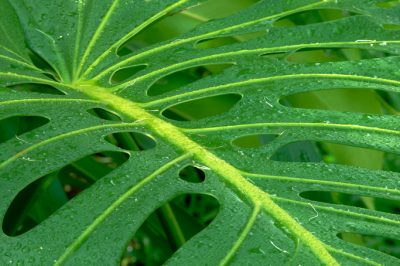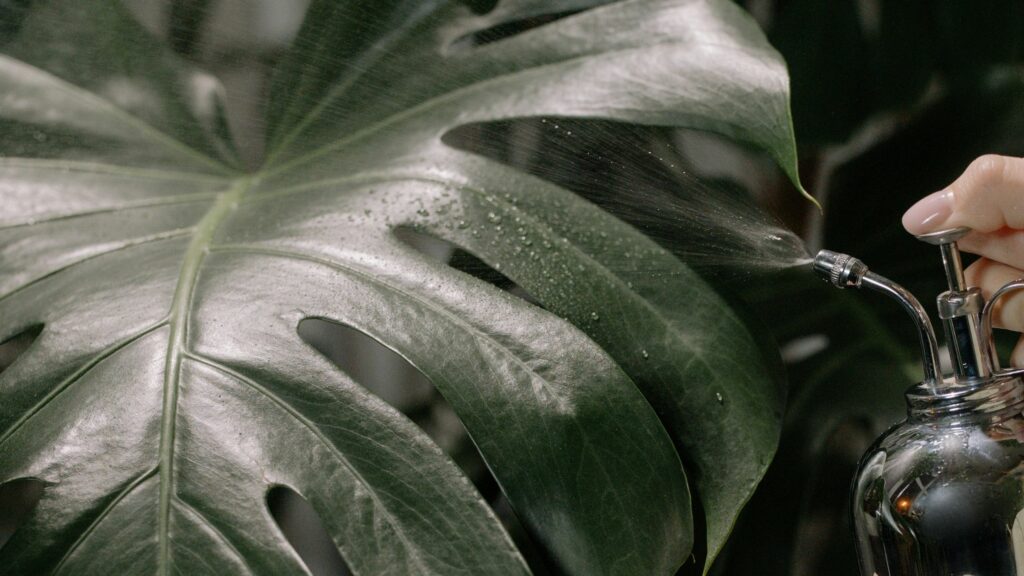Contents
- 1 How much water does the Monstera need?
- 2 Here you can find out which substrate is best for your Monstera.
- 3 How often do you need to water the monstera?
- 4 How do I water the Monstera?
- 5 Monstera watering in winter
- 6 Watering Monstera – what you should pay attention to?
- 7 Provide sufficient moisture
- 8 Monstera and guttation
- 9 How to properly water monstera?
- 10 Author
How much water does the Monstera need?
Make sure that your Monstera deliciosa never gets too much water, but at the same time doesn’t dry out completely. Water your Monstera Deliciosa when the top 2-3 centimeters of the substrate is dry.
Here you can find out which substrate is best for your Monstera.
Best watering water for the Monstera
Distilled, rain or tap water is suitable for watering your Monstera Deliciosa, as long as it is not too calcified.
The water should be at room temperature or substrate temperature so that your monstera does not get a temperature shock.

How often do you need to water the monstera?
How often the monstera needs to be watered depends on its size, number of leaves and the environment. We have had good experience with watering rather every 2 weeks and additionally spraying every 2-3 days.
Since too wet soil quickly leads to root rot, watering should only be done when the top substrate layer is completely dry.
How do I water the Monstera?
Because the Monstera deliciosa does not need much water, you should be sparing when watering.
Unlike other tropical plants, the Monstera has aerial roots that provide it with moisture in addition to the soil roots. So, to create optimal conditions, you should create a good ratio of watering water and humidity.
Monstera watering in winter
In the winter, watering needs are quite a bit lower. However, the same rules for watering your Monstera deliciosa apply as during the rest of the year. Dipping, however, is to be avoided.
The reduced thirst of your Monstera deliciosa is due to the lower light availability and accompanying low temperatures during the cold season. It even goes into a light hibernation, so ideally, it should be brought through the winter with a slightly moist substrate and hardly any fertilizer.
Watering Monstera – what you should pay attention to?
When watering the Monstera, you should make sure that the substrate is watered evenly and that there is no water in the saucer for a short time after watering.
Smaller and thirsty Monstera specimens can also be submerged instead of watered. The advantage of this is that everything is soaked evenly and thoroughly. But even in this case, it must be noted that it was dry before.
Provide sufficient moisture

Spraying or misting your Monstera Deliciosa is advisable to imitate a higher humidity, so that the aerial root can also absorb water.
Distilled water is best for this purpose, as it will not leave lime stains on the leaves of your Monstera.
To provide adequate moisture, a small humidifier is also suitable.
Monstera and guttation
If the monstera has water drops running out over the leaves after watering, for the most part it is doing very well, but has an excess of water. This is called guttation and is not always a bad sign.
How to properly water monstera?
In the care program of Monstera water supply is one of the main pillars. The window leaf originates from the regions of South America, with a warm and humid rainforest climate. It is therefore obvious that proper watering in Central European living spaces requires special attention. Here’s how to water your leafy ornamental plant in an exemplary manner.
Watering Monstera as needed – Here’s how.
Don’t follow a set schedule of taking the watering can to your window foliage. Rather, watering is based on various factors, such as the time of year, local location, or plant size. Here’s how to do it right:
- Aim for a moist substrate that dries up in the meantime.
- When the surface has dried, water thoroughly until the saucer fills up
- After 10 minutes, pour out the saucer
- Spray the leaves regularly with lime-free water
- Please use mainly rainwater or decalcified tap water. If a window leaf is watered primarily with hard water, leaf chlorosis will result, in that the leaves will turn yellow and die.









